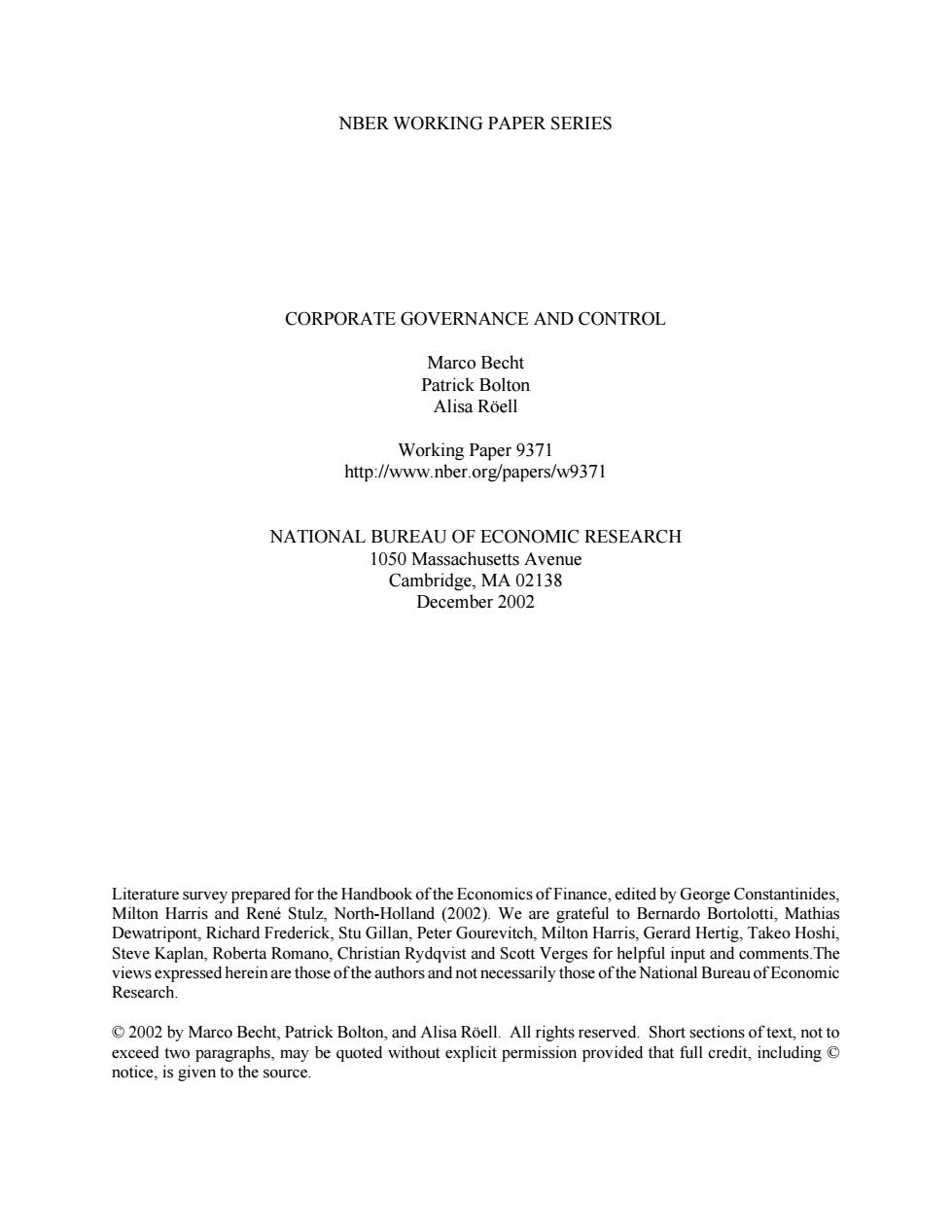
NBER WORKING PAPER SERIES CORPORATE GOVERNANCE AND CONTROL Marco Becht Patrick Bolton Alisa Roell Working Paper 9371 http://www.nber.org/papers/w9371 NATIONAL BUREAU OF ECONOMIC RESEARCH 1050 Massachusetts Avenue Cambridge,MA 02138 December 2002 Literature survey prepared for the Handbook of the Economics of Finance,edited by George Constantinides, Milton Harris and Rene Stulz,North-Holland (2002).We are grateful to Bernardo Bortolotti,Mathias Dewatripont,Richard Frederick,Stu Gillan,Peter Gourevitch,Milton Harris,Gerard Hertig,Takeo Hoshi, Steve Kaplan,Roberta Romano,Christian Rydqvist and Scott Verges for helpful input and comments.The views expressed herein are those of the authors and not necessarily those of the National Bureau of Economic Research 2002 by Marco Becht,Patrick Bolton,and Alisa Roell.All rights reserved.Short sections of text,not to exceed two paragraphs,may be quoted without explicit permission provided that full credit,including notice,is given to the source
NBER WORKING PAPER SERIES CORPORATE GOVERNANCE AND CONTROL Marco Becht Patrick Bolton Alisa Röell Working Paper 9371 http://www.nber.org/papers/w9371 NATIONAL BUREAU OF ECONOMIC RESEARCH 1050 Massachusetts Avenue Cambridge, MA 02138 December 2002 Literature survey prepared for the Handbook of the Economics of Finance, edited by George Constantinides, Milton Harris and René Stulz, North-Holland (2002). We are grateful to Bernardo Bortolotti, Mathias Dewatripont, Richard Frederick, Stu Gillan, Peter Gourevitch, Milton Harris, Gerard Hertig, Takeo Hoshi, Steve Kaplan, Roberta Romano, Christian Rydqvist and Scott Verges for helpful input and comments.The views expressed herein are those of the authors and not necessarily those of the National Bureau of Economic Research. © 2002 by Marco Becht, Patrick Bolton, and Alisa Röell. All rights reserved. Short sections of text, not to exceed two paragraphs, may be quoted without explicit permission provided that full credit, including © notice, is given to the source
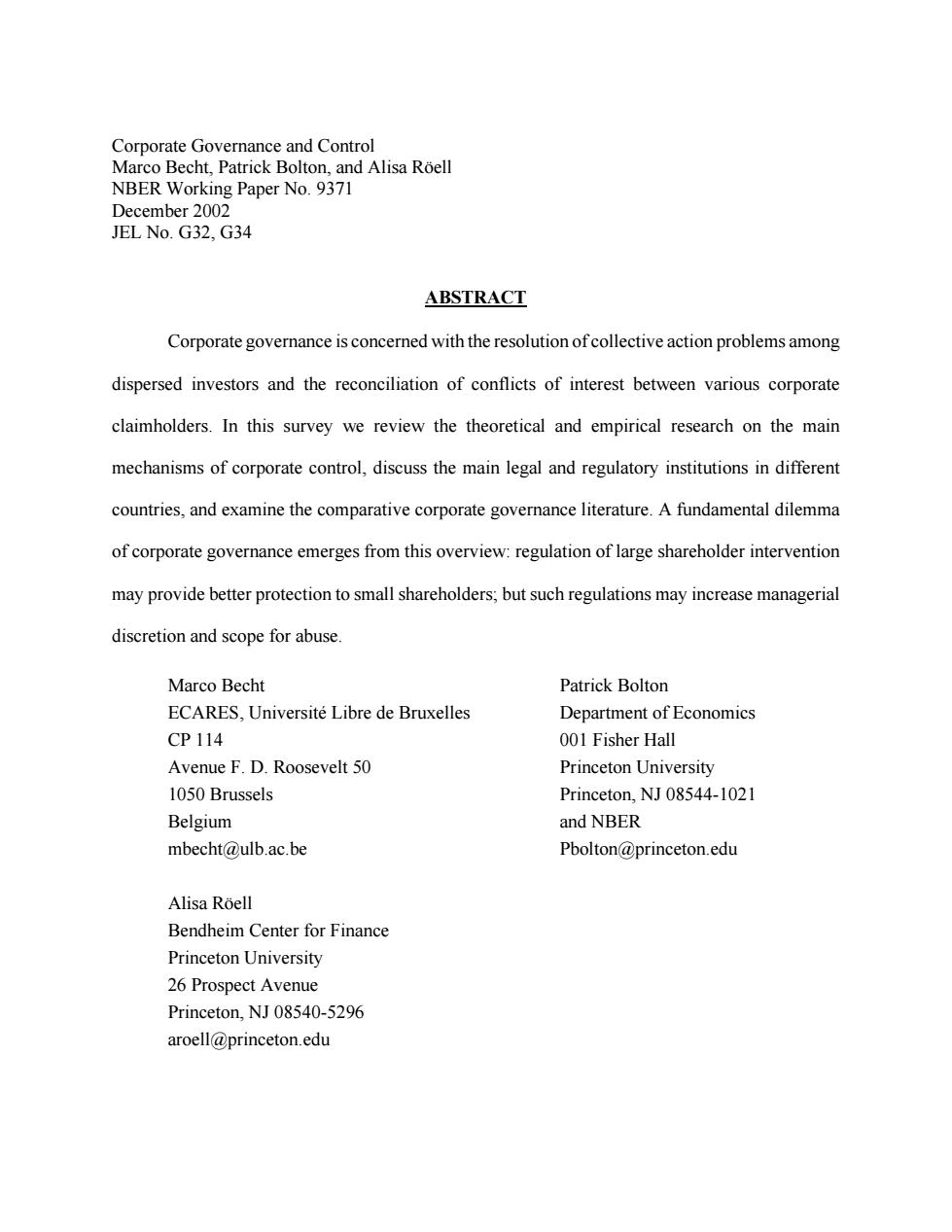
Corporate Governance and Control Marco Becht,Patrick Bolton,and Alisa Roell NBER Working Paper No.9371 December 2002 JEL No.G32,G34 ABSTRACT Corporate governance is concerned with the resolution of collective action problems among dispersed investors and the reconciliation of conflicts of interest between various corporate claimholders.In this survey we review the theoretical and empirical research on the main mechanisms of corporate control,discuss the main legal and regulatory institutions in different countries,and examine the comparative corporate governance literature.A fundamental dilemma of corporate governance emerges from this overview:regulation of large shareholder intervention may provide better protection to small shareholders;but such regulations may increase managerial discretion and scope for abuse. Marco Becht Patrick Bolton ECARES,Universite Libre de Bruxelles Department of Economics CP114 001 Fisher Hall Avenue F.D.Roosevelt 50 Princeton University 1050 Brussels Princeton,NJ 08544-1021 Belgium and NBER mbecht@ulb.ac.be Pbolton@princeton.edu Alisa Roell Bendheim Center for Finance Princeton University 26 Prospect Avenue Princeton,NJ 08540-5296 aroell@princeton.edu
Corporate Governance and Control Marco Becht, Patrick Bolton, and Alisa Röell NBER Working Paper No. 9371 December 2002 JEL No. G32, G34 ABSTRACT Corporate governance is concerned with the resolution of collective action problems among dispersed investors and the reconciliation of conflicts of interest between various corporate claimholders. In this survey we review the theoretical and empirical research on the main mechanisms of corporate control, discuss the main legal and regulatory institutions in different countries, and examine the comparative corporate governance literature. A fundamental dilemma of corporate governance emerges from this overview: regulation of large shareholder intervention may provide better protection to small shareholders; but such regulations may increase managerial discretion and scope for abuse. Marco Becht Patrick Bolton ECARES, Université Libre de Bruxelles Department of Economics CP 114 001 Fisher Hall Avenue F. D. Roosevelt 50 Princeton University 1050 Brussels Princeton, NJ 08544-1021 Belgium and NBER mbecht@ulb.ac.be Pbolton@princeton.edu Alisa Röell Bendheim Center for Finance Princeton University 26 Prospect Avenue Princeton, NJ 08540-5296 aroell@princeton.edu
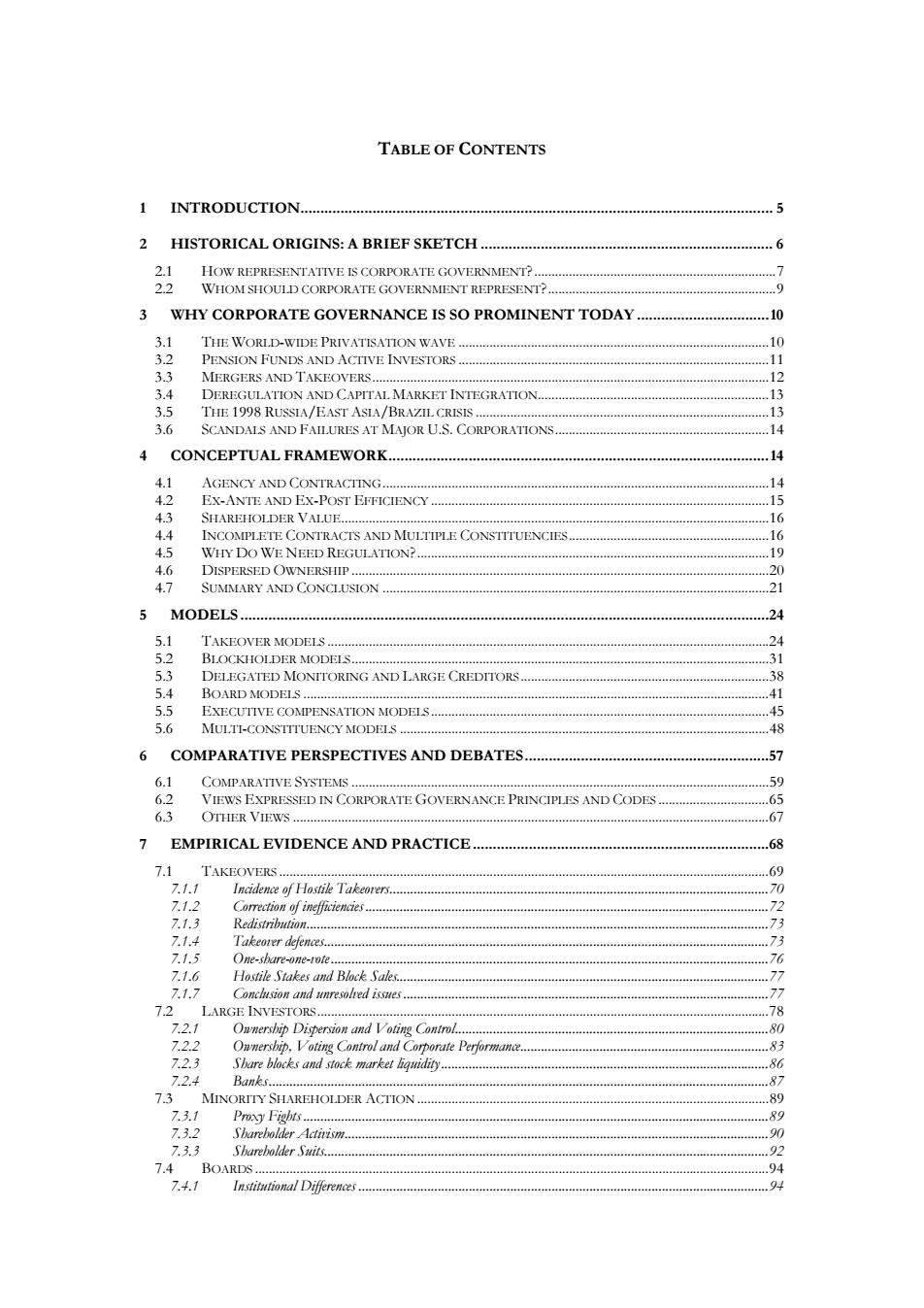
TABLE OF CONTENTS 1 INTRODUCTION.… .5 2 HISTORICAL ORIGINS:A BRIEF SKETCH.................. 6 2.1 HOW REPRESENTATIVE IS CORPORATE GOVERNMENT?........ .7 2.2 WHOM SHOULD CORPORATE GOVERNMENT REPRESENT?. 9 3 WHY CORPORATE GOVERNANCE IS SO PROMINENT TODAY...........0 3.1 THE WORLD-WIDE PRIVATISATION 3.2 PENSION FUNDS AND ACTIVE INVESTORS .11 3.3 MERGERS AND TAKEOVERS..... 3.4 DEREGULATION AND CAPITAL MARKET INTEGRATION. 12 13 3.5 THE 1998 RUSSIA/EAST ASIA/BRAZILCRISIS13 3.6 SCANDALS AND FAILURES AT MAJOR U.S.CORPORATIONS........................14 4 CONCEPTUAL FRAMEWORK........... 14 4.1 AGENCY AND CONTRACTING............ 444444 .14 4.2 EX-ANTE AND EX-POSTEFFICIENCY....15 4.3 SHAREHOLDER VALUE........ 16 4.4 INCOMPLETE CONTRACTS AND MULTIPLE CONSTTTUENCIES.... 4444444444444444444444444 .16 4.5 WHY DO WE NEED REGULATIONP.. 19 4.6 DISPERSED OWNERSHIP 20 4.7 SUMMARY AND CONCLUSION ...... .21 5 MODELS 24 5.1 TAKEOVER MODELS...... 24 5.2 BLOCKHOLDER MODELS........... 31 5.3 DELEGATED MONITORING AND LARGE CREDITORS 38 5.4 B0 ARD MODELS… .41 5.5 EXECUTIVE COMPENSATION MODELS............. 45 5.6 MULTI-CONSTTTUENCY MODELS ............. 48 6 COMPARATIVE PERSPECTIVES AND DEBATES .57 6.1 COMPARATIVE SYSTEMS. 59 6.2 VIEWS EXPRESSED IN CORPORATE GOVERNANCE PRINCIPLES AND CODES..... 65 6.3 OTHER VIEWS.. .67 EMPIRICAL EVIDENCE AND PRACTICE .…68 7.1 TAKEOVERS..... .69 7.1.1 ncidence0fH0.slie☑ke0le.………..70 7.1.2 7.1.3 Recpspppbppiop3 7.1.4 Takeo1 er defences.…… .73 7.1.5 One-share-one-rote... 76 7.1.6 Hostile Stakes and Block Sales. 7.1.7 77 7.2 LARGE INVESTORS.18 7.2.1 Ownership Dispersion and Voting Control. .80 7.2.2 Ownership.Voting Control and Corporate Performance.. 83 7.2.3 Sbare blocks and stock market liquidity. 86 7.2.4 Bahk 87 7.3 MINORITY SHAREHOLDER ACTION......89 73.1 Poxy Fiobts 8 7.3.2 Sbarebolder Activism..... .90 7.3.3 Sbarebolder Suits.. 92 7.4BOARDS. .94 7.4.1 Institutional Differences...... 94
TABLE OF CONTENTS 1 INTRODUCTION...................................................................................................................... 5 2 HISTORICAL ORIGINS: A BRIEF SKETCH ......................................................................... 6 2.1 HOW REPRESENTATIVE IS CORPORATE GOVERNMENT?......................................................................7 2.2 WHOM SHOULD CORPORATE GOVERNMENT REPRESENT?..................................................................9 3 WHY CORPORATE GOVERNANCE IS SO PROMINENT TODAY .................................10 3.1 THE WORLD-WIDE PRIVATISATION WAVE ..........................................................................................10 3.2 PENSION FUNDS AND ACTIVE INVESTORS ..........................................................................................11 3.3 MERGERS AND TAKEOVERS...................................................................................................................12 3.4 DEREGULATION AND CAPITAL MARKET INTEGRATION...................................................................13 3.5 THE 1998 RUSSIA/EAST ASIA/BRAZIL CRISIS .....................................................................................13 3.6 SCANDALS AND FAILURES AT MAJOR U.S. CORPORATIONS..............................................................14 4 CONCEPTUAL FRAMEWORK...............................................................................................14 4.1 AGENCY AND CONTRACTING................................................................................................................14 4.2 EX-ANTE AND EX-POST EFFICIENCY ..................................................................................................15 4.3 SHAREHOLDER VALUE............................................................................................................................16 4.4 INCOMPLETE CONTRACTS AND MULTIPLE CONSTITUENCIES..........................................................16 4.5 WHY DO WE NEED REGULATION?......................................................................................................19 4.6 DISPERSED OWNERSHIP .........................................................................................................................20 4.7 SUMMARY AND CONCLUSION ................................................................................................................21 5 MODELS ....................................................................................................................................24 5.1 TAKEOVER MODELS ................................................................................................................................24 5.2 BLOCKHOLDER MODELS.........................................................................................................................31 5.3 DELEGATED MONITORING AND LARGE CREDITORS........................................................................38 5.4 BOARD MODELS .......................................................................................................................................41 5.5 EXECUTIVE COMPENSATION MODELS ..................................................................................................45 5.6 MULTI-CONSTITUENCY MODELS ...........................................................................................................48 6 COMPARATIVE PERSPECTIVES AND DEBATES.............................................................57 6.1 COMPARATIVE SYSTEMS .........................................................................................................................59 6.2 VIEWS EXPRESSED IN CORPORATE GOVERNANCE PRINCIPLES AND CODES ................................65 6.3 OTHER VIEWS ..........................................................................................................................................67 7 EMPIRICAL EVIDENCE AND PRACTICE..........................................................................68 7.1 TAKEOVERS ..............................................................................................................................................69 7.1.1 Incidence of Hostile Takeovers..............................................................................................................70 7.1.2 Correction of inefficiencies.....................................................................................................................72 7.1.3 Redistribution......................................................................................................................................73 7.1.4 Takeover defences.................................................................................................................................73 7.1.5 One-share-one-vote...............................................................................................................................76 7.1.6 Hostile Stakes and Block Sales............................................................................................................77 7.1.7 Conclusion and unresolved issues ..........................................................................................................77 7.2 LARGE INVESTORS...................................................................................................................................78 7.2.1 Ownership Dispersion and Voting Control...........................................................................................80 7.2.2 Ownership, Voting Control and Corporate Performance........................................................................83 7.2.3 Share blocks and stock market liquidity...............................................................................................86 7.2.4 Banks.................................................................................................................................................87 7.3 MINORITY SHAREHOLDER ACTION ......................................................................................................89 7.3.1 Proxy Fights .......................................................................................................................................89 7.3.2 Shareholder Activism...........................................................................................................................90 7.3.3 Shareholder Suits.................................................................................................................................92 7.4 BOARDS .....................................................................................................................................................94 7.4.1 Institutional Differences .......................................................................................................................94

7.4.2 Board Independence. 7.4.3 95 7+.4 Working of Boards 7.4.5 International Evidence...... 97 7.5 EXECUTIVE COMPENSATION AND CAREERS .97 7.5.1 Background and descriptire statistics............ 7.5.2 97 7.5.3 Are compensation packages well-designed? .99 7.5.4 Are managers paying themselres too much? 7.5.5 mplicit Incentives.… .103 7.5.6 .104 7.6 7.6.1 Debtbolders..... .105 7.6.2 Employees......... .106 8 CONCLUSION.… ..108 RBFBRENCBS115 TABLES 164 TABLE 1.FINANCIAL ASSETS OF INSTTTUTIONAL INVESTORS IN OECD COUNTRIES........ ..164 TABLE 2.NUMBER OF TAKEOVERS BY REGION........ ..165 TABLE 3.CORPORATE TAKEOVER DEFENCES IN THE U.S.... 166 FIGURES…167 FIGURE 1.PRIVATISATION REVENUES BY REGION 1977-97167 FIGURE 2.TOTAL REMUNERATION OF CHIEF EXECUTIVE OFFICER................................168
7.4.2 Board Independence..............................................................................................................................95 7.4.3 Board Composition ..............................................................................................................................96 7.4.4 Working of Boards..............................................................................................................................96 7.4.5 International Evidence.........................................................................................................................97 7.5 EXECUTIVE COMPENSATION AND CAREERS .......................................................................................97 7.5.1 Background and descriptive statistics.....................................................................................................97 7.5.2 Pay-performance sensitivity...................................................................................................................98 7.5.3 Are compensation packages well-designed? ............................................................................................99 7.5.4 Are managers paying themselves too much?.........................................................................................101 7.5.5 Implicit Incentives ..............................................................................................................................103 7.5.6 Conclusion.........................................................................................................................................104 7.6 MULTIPLE CONSTITUENCIES................................................................................................................104 7.6.1 Debtholders.......................................................................................................................................105 7.6.2 Employees .........................................................................................................................................106 8 CONCLUSION ........................................................................................................................108 REFERENCES ................................................................................................................................ 115 TABLES............................................................................................................................................164 TABLE 1. FINANCIAL ASSETS OF INSTITUTIONAL INVESTORS IN OECD COUNTRIES .............................164 TABLE 2. NUMBER OF TAKEOVERS BY REGION.............................................................................................165 TABLE 3. CORPORATE TAKEOVER DEFENCES IN THE U.S...........................................................................166 FIGURES..........................................................................................................................................167 FIGURE 1. PRIVATISATION REVENUES BY REGION 1977-97 ........................................................................167 FIGURE 2. TOTAL REMUNERATION OF CHIEF EXECUTIVE OFFICER .........................................................168
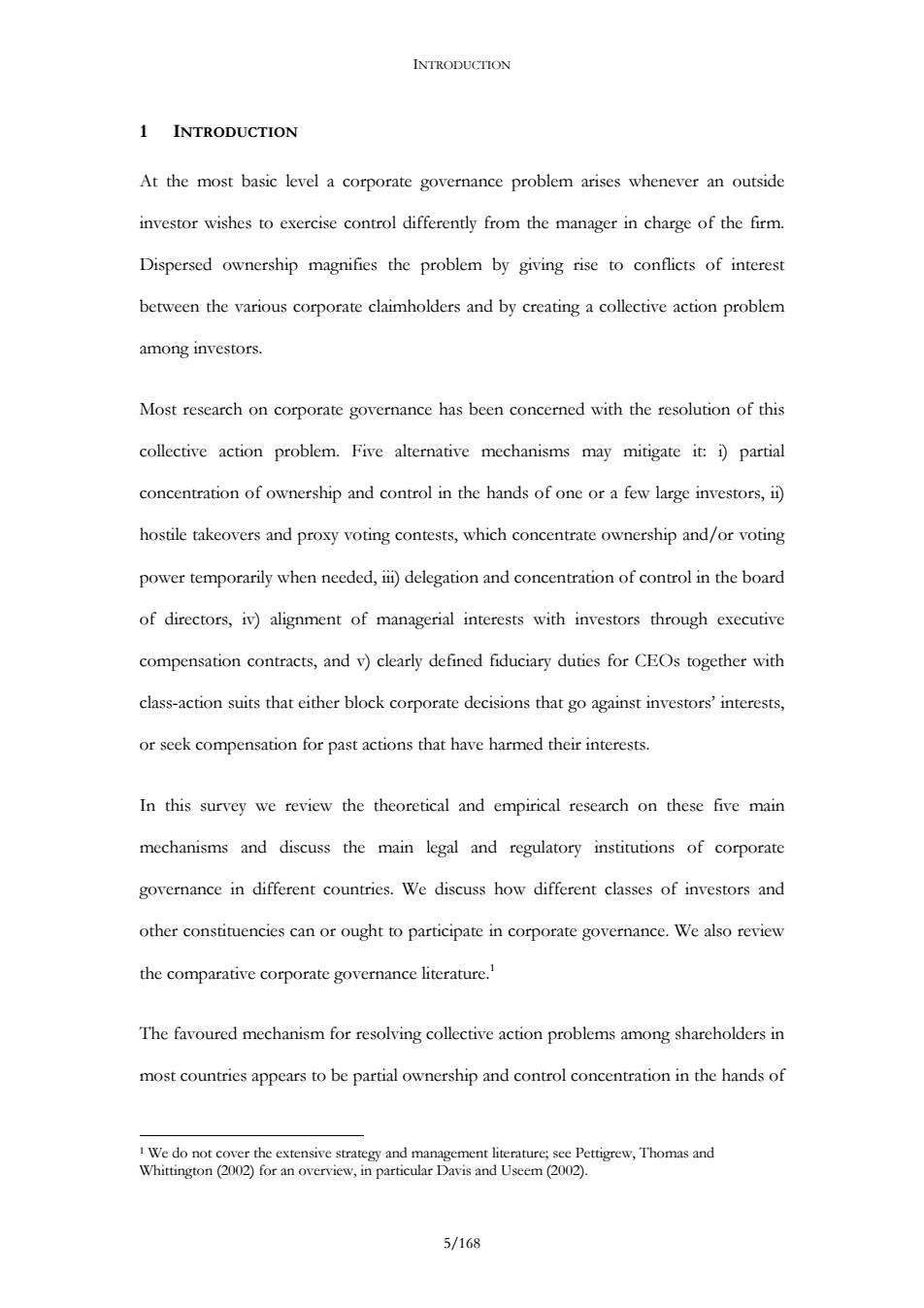
INTRODUCTION 1 INTRODUCTION At the most basic level a corporate governance problem arises whenever an outside investor wishes to exercise control differently from the manager in charge of the firm. Dispersed ownership magnifies the problem by giving rise to conflicts of interest between the various corporate claimholders and by creating a collective action problem among investors. Most research on corporate governance has been concerned with the resolution of this collective action problem.Five alternative mechanisms may mitigate it:i)partial concentration of ownership and control in the hands of one or a few large investors,ii) hostile takeovers and proxy voting contests,which concentrate ownership and/or voting power temporarily when needed,ii)delegation and concentration of control in the board of directors,iv)alignment of managerial interests with investors through executive compensation contracts,and v)clearly defined fiduciary duties for CEOs together with class-action suits that either block corporate decisions that go against investors'interests, or seek compensation for past actions that have harmed their interests. In this survey we review the theoretical and empirical research on these five main mechanisms and discuss the main legal and regulatory institutions of corporate governance in different countries.We discuss how different classes of investors and other constituencies can or ought to participate in corporate governance.We also review the comparative corporate governance literature. The favoured mechanism for resolving collective action problems among shareholders in most countries appears to be partial ownership and control concentration in the hands of 1 We do not cover the extensive strategy and management literature;see Pettigrew,Thomas and Whittington (2002)for an overview,in particular Davis and Useem(2002). 5/168
INTRODUCTION 1 INTRODUCTION At the most basic level a corporate governance problem arises whenever an outside investor wishes to exercise control differently from the manager in charge of the firm. Dispersed ownership magnifies the problem by giving rise to conflicts of interest between the various corporate claimholders and by creating a collective action problem among investors. Most research on corporate governance has been concerned with the resolution of this collective action problem. Five alternative mechanisms may mitigate it: i) partial concentration of ownership and control in the hands of one or a few large investors, ii) hostile takeovers and proxy voting contests, which concentrate ownership and/or voting power temporarily when needed, iii) delegation and concentration of control in the board of directors, iv) alignment of managerial interests with investors through executive compensation contracts, and v) clearly defined fiduciary duties for CEOs together with class-action suits that either block corporate decisions that go against investors’ interests, or seek compensation for past actions that have harmed their interests. In this survey we review the theoretical and empirical research on these five main mechanisms and discuss the main legal and regulatory institutions of corporate governance in different countries. We discuss how different classes of investors and other constituencies can or ought to participate in corporate governance. We also review the comparative corporate governance literature.1 The favoured mechanism for resolving collective action problems among shareholders in most countries appears to be partial ownership and control concentration in the hands of 1 We do not cover the extensive strategy and management literature; see Pettigrew, Thomas and Whittington (2002) for an overview, in particular Davis and Useem (2002). 5/168
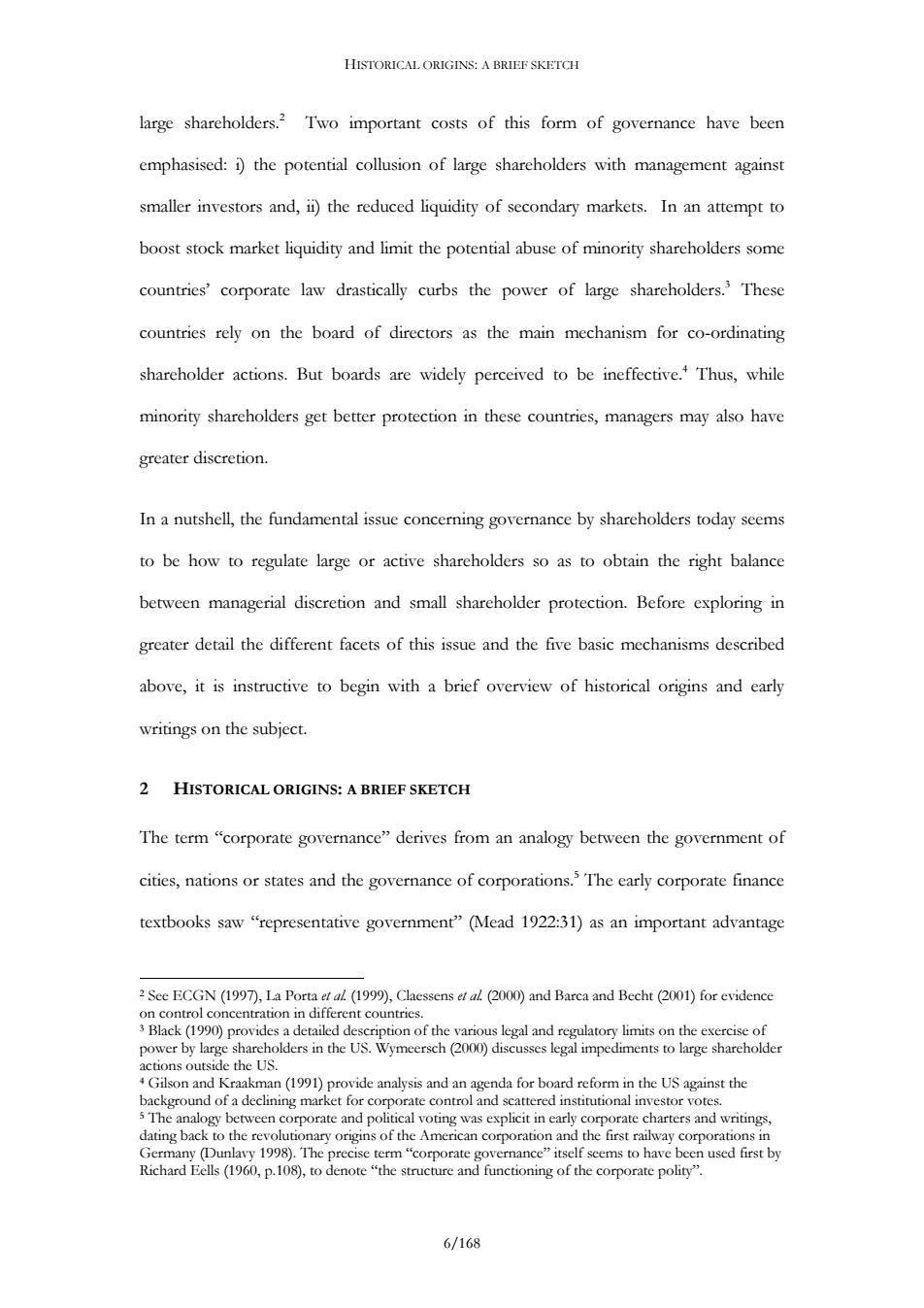
HISTORICAL ORIGINS:A BRIEF SKETCH large shareholders.?Two important costs of this form of governance have been emphasised:i)the potential collusion of large shareholders with management against smaller investors and,ii)the reduced liquidity of secondary markets.In an attempt to boost stock market liquidity and limit the potential abuse of minority shareholders some countries'corporate law drastically curbs the power of large shareholders.3 These countries rely on the board of directors as the main mechanism for co-ordinating shareholder actions.But boards are widely perceived to be ineffective.Thus,while minority shareholders get better protection in these countries,managers may also have greater discretion. In a nutshell,the fundamental issue concerning governance by shareholders today seems to be how to regulate large or active shareholders so as to obtain the right balance between managerial discretion and small shareholder protection.Before exploring in greater detail the different facets of this issue and the five basic mechanisms described above,it is instructive to begin with a brief overview of historical origins and early writings on the subject. 2 HISTORICAL ORIGINS:A BRIEF SKETCH The term "corporate governance"derives from an analogy between the government of cities,nations or states and the governance of corporations.The early corporate finance textbooks saw "representative government"(Mead 1922:31)as an important advantage 2 See ECGN (1997),La Porta etal (1999),Claessens etal(2000)and Barca and Becht(2001)for evidence on control concentration in different countries. 3 Black(1990)provides a detailed description of the various legal and regulatory limits on the exercise of power by large shareholders in the US.Wymeersch(2000)discusses legal impediments to large shareholder actions outside the US. 4 Gilson and Kraakman(1991)provide analysis and an agenda for board reform in the US against the background of a declining market for corporate control and scattered institutional investor votes. 5The analogy between corporate and political voting was explicit in early corporate charters and writings, dating back to the revolutionary origins of the American corporation and the first railway corporations in Germany (Dunlavy 1998).The precise term"corporate governance"itself seems to have been used first by Richard Eells (1960,p.108),to denote "the structure and functioning of the corporate polity". 6/168
HISTORICAL ORIGINS: A BRIEF SKETCH large shareholders.2 Two important costs of this form of governance have been emphasised: i) the potential collusion of large shareholders with management against smaller investors and, ii) the reduced liquidity of secondary markets. In an attempt to boost stock market liquidity and limit the potential abuse of minority shareholders some countries’ corporate law drastically curbs the power of large shareholders.3 These countries rely on the board of directors as the main mechanism for co-ordinating shareholder actions. But boards are widely perceived to be ineffective.4 Thus, while minority shareholders get better protection in these countries, managers may also have greater discretion. In a nutshell, the fundamental issue concerning governance by shareholders today seems to be how to regulate large or active shareholders so as to obtain the right balance between managerial discretion and small shareholder protection. Before exploring in greater detail the different facets of this issue and the five basic mechanisms described above, it is instructive to begin with a brief overview of historical origins and early writings on the subject. 2 HISTORICAL ORIGINS: A BRIEF SKETCH The term “corporate governance” derives from an analogy between the government of cities, nations or states and the governance of corporations.5 The early corporate finance textbooks saw “representative government” (Mead 1922:31) as an important advantage 2 See ECGN (1997), La Porta et al. (1999), Claessens et al. (2000) and Barca and Becht (2001) for evidence on control concentration in different countries. 3 Black (1990) provides a detailed description of the various legal and regulatory limits on the exercise of power by large shareholders in the US. Wymeersch (2000) discusses legal impediments to large shareholder actions outside the US. 4 Gilson and Kraakman (1991) provide analysis and an agenda for board reform in the US against the background of a declining market for corporate control and scattered institutional investor votes. 5 The analogy between corporate and political voting was explicit in early corporate charters and writings, dating back to the revolutionary origins of the American corporation and the first railway corporations in Germany (Dunlavy 1998). The precise term “corporate governance” itself seems to have been used first by Richard Eells (1960, p.108), to denote “the structure and functioning of the corporate polity”. 6/168

HISTORICAL ORIGINS:A BRIEF SKETCH of the corporation over partnerships but there has been and still is little agreement on how representative corporate governance really is,or whom it should represent. 2.1 How representative is corporate government? The institutional arrangements surrounding corporate elections and the role and fiduciary duties of the board have been the central themes in the corporate governance literature from its inception.The dilemma of how to balance limits on managerial discretion and small investor protection is ever present.Should one limit the power of corporate plutocrats (large shareholders or voting trusts)or should one tolerate concentrated voting power as a way of limiting managerial discretion? The concern of early writers of corporate charters was the establishment of "corporate suffrage",where each member (shareholder)had one vote (Dunlavy 1998).The aim was to establish "democracy"by eliminating special privileges of some members and by limiting the number of votes each shareholder could cast,irrespective of the number of shares held.However,just as "corporate democracy"was being established it was already being transformed into "plutocracy"by moving towards "one-share-one-vote" and thus allowing for concentrated ownership and control (Dunlavy 1998). In the U.S.this was followed by two distinct systems of "corporate feudalism":first,to the voting trusts"and holding companies'(Cushing 1915,Mead 1905,Liefmann 1909, 6 Frequently voting scales were used to achieve this aim.For example,under the voting scale imposed by a Virginia law of 1836 shareholders of manufacturing corporations cast"one vote for each share up to 15, one vote for every five shares from 15 to 100,and one vote for each increment of 20 shares above 100 shares"(Dunlavy 1998:18). 7 Voting right restrictions survived until very recently in Germany (Franks and Mayer 2001).They are still in use in Denmark,France,Spain and other European countries(Becht and Mayer 2001). Under a typical voting trust agreement shareholders transfer their shares to a trust and receive certificates in return.The certificate holders elect a group of trustees who vote the deposited shares.Voting trusts were an improvement over pooling agreements and designed to restrict product market competition.They offered two principal advantages:putting the stock of several companies into the voting trust ensured that the trustees had permanent control over the management of the various operating companies,allowing 7/168
HISTORICAL ORIGINS: A BRIEF SKETCH of the corporation over partnerships but there has been and still is little agreement on how representative corporate governance really is, or whom it should represent. 2.1 How representative is corporate government? The institutional arrangements surrounding corporate elections and the role and fiduciary duties of the board have been the central themes in the corporate governance literature from its inception. The dilemma of how to balance limits on managerial discretion and small investor protection is ever present. Should one limit the power of corporate plutocrats (large shareholders or voting trusts) or should one tolerate concentrated voting power as a way of limiting managerial discretion? The concern of early writers of corporate charters was the establishment of “corporate suffrage”, where each member (shareholder) had one vote (Dunlavy 1998). The aim was to establish “democracy” by eliminating special privileges of some members and by limiting the number of votes each shareholder could cast, irrespective of the number of shares held.6 However, just as “corporate democracy” was being established it was already being transformed into “plutocracy” by moving towards “one-share-one-vote” and thus allowing for concentrated ownership and control (Dunlavy 1998).7 In the U.S. this was followed by two distinct systems of “corporate feudalism”: first, to the voting trusts8 and holding companies9 (Cushing 1915, Mead 1905, Liefmann 1909, 6 Frequently voting scales were used to achieve this aim. For example, under the voting scale imposed by a Virginia law of 1836 shareholders of manufacturing corporations cast “one vote for each share up to 15, one vote for every five shares from 15 to 100, and one vote for each increment of 20 shares above 100 shares” (Dunlavy 1998:18). 7 Voting right restrictions survived until very recently in Germany (Franks and Mayer 2001). They are still in use in Denmark, France, Spain and other European countries (Becht and Mayer 2001). 8 Under a typical voting trust agreement shareholders transfer their shares to a trust and receive certificates in return. The certificate holders elect a group of trustees who vote the deposited shares. Voting trusts were an improvement over pooling agreements and designed to restrict product market competition. They offered two principal advantages: putting the stock of several companies into the voting trust ensured that the trustees had permanent control over the management of the various operating companies, allowing 7/168

HISTORICAL ORIGINS:A BRIEF SKETCH 20)originating in the "Gilded Age"(Iwain and Warner 1873)10 and later to the managerial corporation.Thecaptains of industry"in the trusts and hierarchical groups controlled the majority of votes in vast corporate empires with relatively small(er) amounts of capital,allowing them to exert product market power and leaving ample room for self-dealing.2 In contrast,the later managerial corporations were controlled mainly by professional managers and most of their shareholders were too small and numerous to have a say.In these firms control was effectively separated from ownership.1 Today corporate feudalism of the managerial variety in the U.S.and the "captain of industry"kind elsewhere is challenged by calls for more "shareholder democracy",a global movement that finds its roots with the "corporate Jacksonians"of the 1960s in the U.S.14 them to enforce a common policy on output and prices;the certificates issued by the voting trust could be widely placed and traded on a stock exchange. Holding companies have the purpose of owning and voting shares in other companies.After the passage of the Sherman Antitrust Act in 1890 many of the voting trusts converted themselves into New Jersey registered holding companies ("industrial combinations')that were identical in function,but escaped the initial round of antitrust legislation,for example the Sugar Trust in 1891 (Mead 1905,pg.44)and Rockefeller's Standard Oil in 1892(Mead 1905,pg.35). 10 The "captains of industry"of this era,are also referred to as the "Robber Barons"(Josephson 1934,De Long 1998),were the target of an early anti-trust movement that culminated in the election of Woodrow Wilson as US President in 1912.Standard Oil was broken up even before (in 1911)under the Sherman Act of 1890 and converted from a corporation that was tightly controlled by the Rockefeller clan to a managerial corporation.Trust finance disappeared from the early corporate finance textbooks(for example Mead 1912 versus Mead 1922).In 1929 Rockefeller Jr.(14.9%)ousted the scandal ridden Chairman of Standard Oil of Indiana,who enjoyed the full support of his board,only by small margin,an example that was widely used for illustrating how much the balance of power had swung from the "Robber Barons"to management(Berle and Means 1932:82-83,cited in Galbraith 1967),another type of feudal lord. 11 For Berle and Means(1930):"the]"publicly owned"stock corporation in America...constitutes an institution analogous to the feudal system in the Middle Ages". 12They also laid the foundations for some of the World's finest arts collections,philanthropic foundations and university endowments. is This"separation of ownership and control"triggered a huge public and academic debate of"the corporate problem";see,for example,the Berle and Means symposia in the Columbia Law Review (1964) and the Journal of Law and Economics (1983).Before Means (1931a,b)and Berle and Means (1930,32) the point was argued in Lippmann(1914),Veblen (1923)Carver(1925),Ripley (1927)and Wormser (1931);see Hessen(1983). 14 Non-Americans often consider shareholder activism as a free-market movement and associated calls for more small shareholder power as a part of the conservative agenda.They are puzzled when they learn that shareholder activism today has its roots in part of the anti-Vietnam War,anti-apartheid and anti-tobacco movements and has close links with the unions.In terms of government (of corporations)there is no 8/168
HISTORICAL ORIGINS: A BRIEF SKETCH 20) originating in the “Gilded Age” (Twain and Warner 1873)10 and later to the managerial corporation.11 The “captains of industry” in the trusts and hierarchical groups controlled the majority of votes in vast corporate empires with relatively small(er) amounts of capital, allowing them to exert product market power and leaving ample room for self-dealing.12 In contrast, the later managerial corporations were controlled mainly by professional managers and most of their shareholders were too small and numerous to have a say. In these firms control was effectively separated from ownership.13 Today corporate feudalism of the managerial variety in the U.S. and the “captain of industry” kind elsewhere is challenged by calls for more “shareholder democracy”, a global movement that finds its roots with the “corporate Jacksonians” of the 1960s in the U.S.14 them to enforce a common policy on output and prices; the certificates issued by the voting trust could be widely placed and traded on a stock exchange. 9 Holding companies have the purpose of owning and voting shares in other companies. After the passage of the Sherman Antitrust Act in 1890 many of the voting trusts converted themselves into New Jersey registered holding companies (“industrial combinations”) that were identical in function, but escaped the initial round of antitrust legislation, for example the Sugar Trust in 1891 (Mead 1905, pg. 44) and Rockefeller’s Standard Oil in 1892 (Mead 1905, pg. 35). 10 The “captains of industry” of this era, are also referred to as the “Robber Barons” (Josephson 1934, De Long 1998), were the target of an early anti-trust movement that culminated in the election of Woodrow Wilson as US President in 1912. Standard Oil was broken up even before (in 1911) under the Sherman Act of 1890 and converted from a corporation that was tightly controlled by the Rockefeller clan to a managerial corporation. Trust finance disappeared from the early corporate finance textbooks (for example Mead 1912 versus Mead 1922). In 1929 Rockefeller Jr. (14.9%) ousted the scandal ridden Chairman of Standard Oil of Indiana, who enjoyed the full support of his board, only by small margin, an example that was widely used for illustrating how much the balance of power had swung from the “Robber Barons” to management (Berle and Means 1932:82-83, cited in Galbraith 1967), another type of feudal lord. 11 For Berle and Means (1930): “[the] “publicly owned” stock corporation in America… constitutes an institution analogous to the feudal system in the Middle Ages”. 12 They also laid the foundations for some of the World’s finest arts collections, philanthropic foundations and university endowments. 13 This “separation of ownership and control” triggered a huge public and academic debate of “the corporate problem”; see, for example, the Berle and Means symposia in the Columbia Law Review (1964) and the Journal of Law and Economics (1983). Before Means (1931a,b) and Berle and Means (1930, 32) the point was argued in Lippmann (1914), Veblen (1923) Carver (1925), Ripley (1927) and Wormser (1931); see Hessen (1983). 14 Non-Americans often consider shareholder activism as a free-market movement and associated calls for more small shareholder power as a part of the conservative agenda. They are puzzled when they learn that shareholder activism today has its roots in part of the anti-Vietnam War, anti-apartheid and anti-tobacco movements and has close links with the unions. In terms of government (of corporations) there is no 8/168
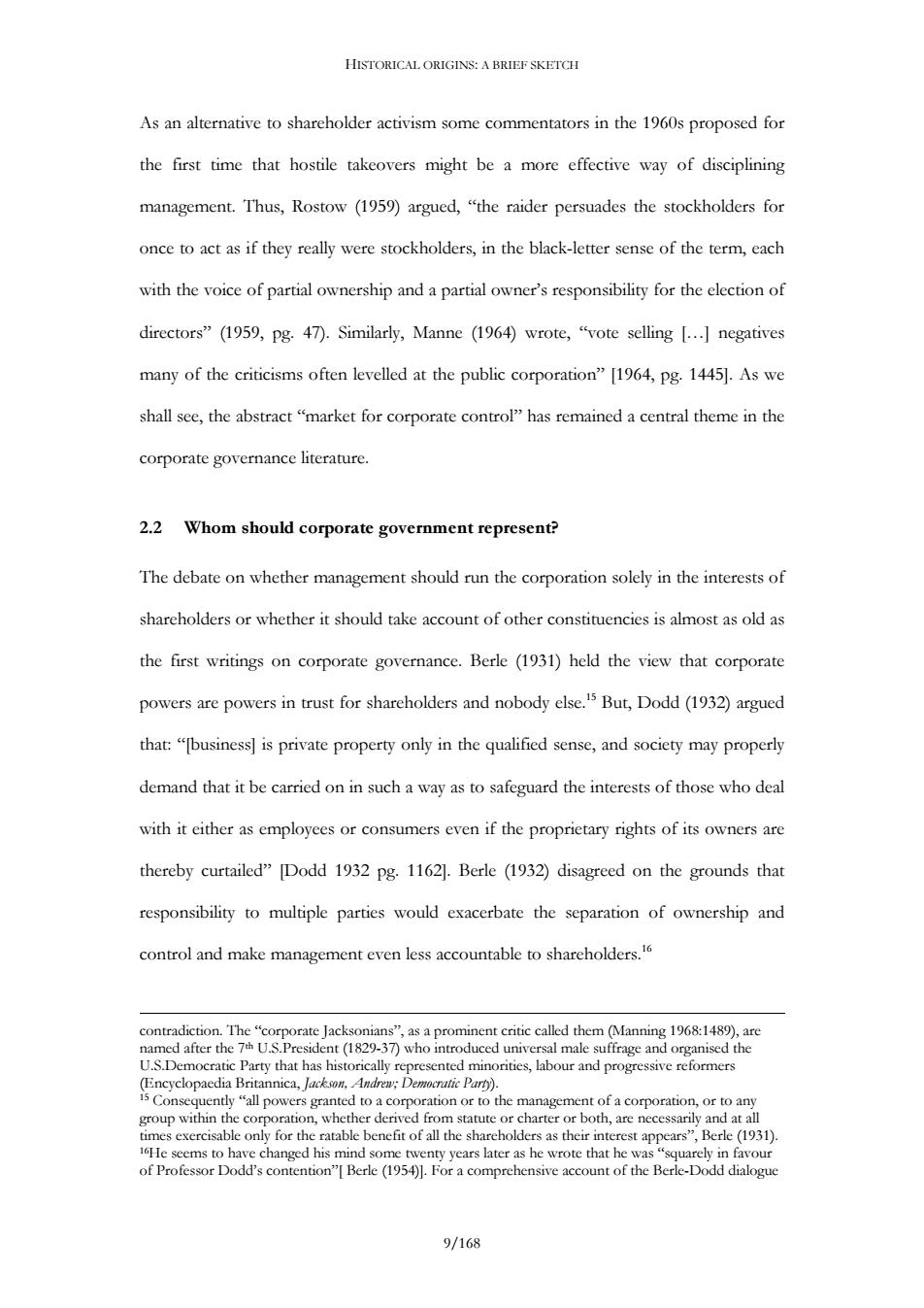
HISTORICAL ORIGINS:A BRIEF SKETCH As an alternative to shareholder activism some commentators in the 1960s proposed for the first time that hostile takeovers might be a more effective way of disciplining management.Thus,Rostow (1959)argued,"the raider persuades the stockholders for once to act as if they really were stockholders,in the black-letter sense of the term,each with the voice of partial ownership and a partial owner's responsibility for the election of directors"(1959,pg.47).Similarly,Manne (1964)wrote,"vote selling [...negatives many of the criticisms often levelled at the public corporation"[1964,pg.1445].As we shall see,the abstract "market for corporate control"has remained a central theme in the corporate governance literature. 2.2 Whom should corporate government represent? The debate on whether management should run the corporation solely in the interests of shareholders or whether it should take account of other constituencies is almost as old as the first writings on corporate governance.Berle (1931)held the view that corporate powers are powers in trust for shareholders and nobody else.But,Dodd(1932)argued that:"business]is private property only in the qualified sense,and society may properly demand that it be carried on in such a way as to safeguard the interests of those who deal with it either as employees or consumers even if the proprietary rights of its owners are thereby curtailed"Dodd 1932 pg.1162].Berle (1932)disagreed on the grounds that responsibility to multiple parties would exacerbate the separation of ownership and control and make management even less accountable to shareholders.16 contradiction.The "corporate Jacksonians",as a prominent critic called them (Manning 1968:1489),are named after the 7th U.S.President(1829-37who introduced universal male suffrage and organised the U.S.Democratic Party that has historically represented minorities,labour and progressive reformers (Encyclopaedia Britannica,lackson,Andren;Democratic Part). is Consequently "all powers granted to a corporation or to the management of a corporation,or to any group within the corporation,whether derived from statute or charter or both,are necessarily and at all times exercisable only for the ratable benefit of all the shareholders as their interest appears",Berle(1931). 16He seems to have changed his mind some twenty years later as he wrote that he was"squarely in favour of Professor Dodd's contention"Berle (1954).For a comprehensive account of the Berle-Dodd dialogue 9/168
HISTORICAL ORIGINS: A BRIEF SKETCH As an alternative to shareholder activism some commentators in the 1960s proposed for the first time that hostile takeovers might be a more effective way of disciplining management. Thus, Rostow (1959) argued, “the raider persuades the stockholders for once to act as if they really were stockholders, in the black-letter sense of the term, each with the voice of partial ownership and a partial owner’s responsibility for the election of directors” (1959, pg. 47). Similarly, Manne (1964) wrote, “vote selling […] negatives many of the criticisms often levelled at the public corporation” [1964, pg. 1445]. As we shall see, the abstract “market for corporate control” has remained a central theme in the corporate governance literature. 2.2 Whom should corporate government represent? The debate on whether management should run the corporation solely in the interests of shareholders or whether it should take account of other constituencies is almost as old as the first writings on corporate governance. Berle (1931) held the view that corporate powers are powers in trust for shareholders and nobody else.15 But, Dodd (1932) argued that: “[business] is private property only in the qualified sense, and society may properly demand that it be carried on in such a way as to safeguard the interests of those who deal with it either as employees or consumers even if the proprietary rights of its owners are thereby curtailed” [Dodd 1932 pg. 1162]. Berle (1932) disagreed on the grounds that responsibility to multiple parties would exacerbate the separation of ownership and control and make management even less accountable to shareholders.16 contradiction. The “corporate Jacksonians”, as a prominent critic called them (Manning 1968:1489), are named after the 7th U.S.President (1829-37) who introduced universal male suffrage and organised the U.S.Democratic Party that has historically represented minorities, labour and progressive reformers (Encyclopaedia Britannica, Jackson, Andrew; Democratic Party). 15 Consequently “all powers granted to a corporation or to the management of a corporation, or to any group within the corporation, whether derived from statute or charter or both, are necessarily and at all times exercisable only for the ratable benefit of all the shareholders as their interest appears”, Berle (1931). 16He seems to have changed his mind some twenty years later as he wrote that he was “squarely in favour of Professor Dodd’s contention”[ Berle (1954)]. For a comprehensive account of the Berle-Dodd dialogue 9/168

WHY CORPORATE GOVERNANCE IS SO PROMINENT TODAY There is nowadays a voluminous literature on corporate governance.On many key issues our understanding has improved enormously since the 1930s.Remarkably though,some of the main issues over which the early writers have been debating remain central today. 3 WHY CORPORATE GOVERNANCE IS SO PROMINENT TODAY Why has corporate governance become such a prominent topic in the past two decades or so and not before?We have identified,in no particular order,the following reasons:i) the world-wide wave of privatisation of the past two decades,ii)pension fund reform and the growth of private savings,ii)the takeover wave of the 1980s,iv)deregulation and the integration of capital markets,v)the 1998 East Asia crisis,which has put the spotlight on corporate governance in emerging markets vi)a series of recent U.S. scandals and corporate failures that built up but did not surface during the bull market of the late 1990s 3.1 The World-wide Privatisation wave Privatisation has been an important phenomenon in Latin America,Western Europe, Asia and (obviously)the former Soviet block,but not in the U.S.where state ownership of enterprises has always been very small(see Figure 1).On average,since 1990 OECD privatisation programmes have generated proceeds equivalent to 2.7%of total GDP,and in some cases up to 27%of country GDP.The privatisation wave started in the U.K., which was responsible for 58%of OECD and 90%of European Community privatisation proceeds in 1991.Since 1995 Australia,Italy,France,Japan and Spain alone have generated 60%of total privatisation revenues. see Weiner(1964)and for additional papers arguing both points of view Mason(1959).Galbraith (1967in his influential "The New Industrial State"took Dodd's position. 10/168
WHY CORPORATE GOVERNANCE IS SO PROMINENT TODAY There is nowadays a voluminous literature on corporate governance. On many key issues our understanding has improved enormously since the 1930s. Remarkably though, some of the main issues over which the early writers have been debating remain central today. 3 WHY CORPORATE GOVERNANCE IS SO PROMINENT TODAY Why has corporate governance become such a prominent topic in the past two decades or so and not before? We have identified, in no particular order, the following reasons: i) the world-wide wave of privatisation of the past two decades, ii) pension fund reform and the growth of private savings, iii) the takeover wave of the 1980s, iv) deregulation and the integration of capital markets, v) the 1998 East Asia crisis, which has put the spotlight on corporate governance in emerging markets vi) a series of recent U.S. scandals and corporate failures that built up but did not surface during the bull market of the late 1990s 3.1 The World-wide Privatisation wave Privatisation has been an important phenomenon in Latin America, Western Europe, Asia and (obviously) the former Soviet block, but not in the U.S. where state ownership of enterprises has always been very small (see Figure 1). On average, since 1990 OECD privatisation programmes have generated proceeds equivalent to 2.7% of total GDP, and in some cases up to 27% of country GDP. The privatisation wave started in the U.K., which was responsible for 58% of OECD and 90% of European Community privatisation proceeds in 1991. Since 1995 Australia, Italy, France, Japan and Spain alone have generated 60% of total privatisation revenues. see Weiner (1964) and for additional papers arguing both points of view Mason (1959). Galbraith (1967) in his influential “The New Industrial State” took Dodd’s position. 10/168